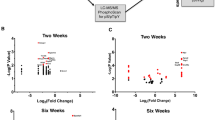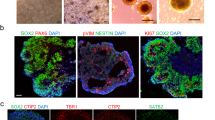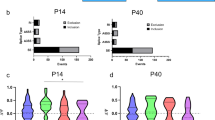Abstract
Unlike some other childhood neurodevelopmental disorders, no diagnostic biochemical marker has been identified in all individuals with an autism spectrum disorder (ASD). This deficit likely results from genetic heterogeneity among the population. Therefore, we evaluated a subset of individuals with ASDs, specifically, individuals with or without macrocephaly in the presence or absence of PTEN mutations. We sought to determine if amino or organic acid markers could be used to identify individuals with ASDs with or without macrocephaly in the presence or absence of PTEN mutations, and to establish the degree of macrocephaly in individuals with ASDs and PTEN mutation. Urine, blood and occipital–frontal circumference (OFC) measurements were collected from 69 individuals meeting DSM-IV-TR criteria. Urine and plasma samples were subjected to amino and organic acid analyses. PTEN was Sanger-sequenced from germline genomic DNA. Germline PTEN mutations were identified in 27% (6/22) of the macrocephalic ASD population. All six PTEN mutation-positive individuals were macrocephalic with average OFC+4.35 standard deviations (SDs) above the mean. No common biochemical abnormalities were identified in macrocephalic ASD individuals with or without PTEN mutations. In contrast, among the collective ASD population, elevation of urine aspartic acid (87%; 54/62), plasma taurine (69%; 46/67) and reduction of plasma cystine (72%; 46/64) were observed. PTEN sequencing should be carried out for all individuals with ASDs and macrocephaly with OFC ≥2SDs above the mean. A proportion of individuals with ASDs may have an underlying disorder in sulfur amino acid metabolism.
Similar content being viewed by others
Log in or create a free account to read this content
Gain free access to this article, as well as selected content from this journal and more on nature.com
or
References
Ronald A, Hoekstra RA : Autism spectrum disorders and autistic traits: a decade of new twin studies. Am J Med Genet B Neuropsychiatr Genet 2011; 156B: 255–274.
Abrahams BS, Geschwind DH : Advances in autism genetics: on the threshold of a new neurobiology. Nat Rev Genet 2008; 9: 341–355.
Rapin I : Autism. N Engl J Med. 1997; 337: 97–104.
Baio J : Prevalence of autism spectrum disorders—Autism and Developmental Disabilities Monitoring Network, 14 Sites, United States, 2008. Morbidity and Mortality Weekly Report (MMWR), (30 March 2012/61(SS03)): 1–19.
Miles JH, Takahashi TN, Hong J et al: Development and validation of a measure of dysmorphology: useful for autism subgroup classification. Am J Med Genet A 2008; 146A: 1101–1116.
Ingram DG, Takahashi TN, Miles JH : Defining autism subgroups: a taxometric solution. J Autism Dev Disord 2008; 38: 950–960.
Courchesne E, Carper R, Akshoomoff N : Evidence of brain overgrowth in the first year of life in autism. JAMA 2003; 290: 337–344.
Butler MG, Dasouki MJ, Zhou XP et al: Subset of individuals with autism spectrum disorders and extreme macrocephaly associated with germline PTEN tumour suppressor gene mutations. J Med Genet 2005; 42: 318–321.
McBride KL, Varga EA, Pastore MT et al: Confirmation study of PTEN mutations among individuals with autism or developmental delays/mental retardation and macrocephaly. Autism Res 2010; 3: 137–141.
Varga EA, Pastore M, Prior T, Herman GE, McBride KL : The prevalence of PTEN mutations in a clinical pediatric cohort with autism spectrum disorders, developmental delay, and macrocephaly. Genet Med 2009; 11: 111–117.
Williams CA, Dagli A, Battaglia A : Genetic disorders associated with macrocephaly. Am J Med Genet A 2008; 146A: 2023–2037.
Hobert JA, Mester JL, Moline J, Eng C : Elevated plasma succinate in PTEN, SDHB, and SDHD mutation-positive individuals. Genet Med 2012; 14: 616–619.
Roche AF, Mukherjee D, Guo SM, Moore WM : Head circumference reference data: birth to 18 years. Pediatrics 1987; 79: 706–712.
C. f. D. C. a. P. NCfHS: Centers for Disease Control. Clinical growth chars, 2005. Available at http://www.cdc.gov/growthcharts/clinical_charts.htm#Set2.
Lord CRM, DiLavore PC, Risi S : Autism Diagnostic Observation Schedule: ADOS manual. Los Angeles, CA, USA, 2002.
Constantino JN, Todd RD : Intergenerational transmission of subthreshold autistic traits in the general population. Biol Psychiatry 2005; 57: 655–660.
Constantino JN, Gruber CP : Social Responsiveness Scale: Manual; In: Book Social Responsiveness Scale: Manual. Los Angeles, CA: Western Psychological Services, 2005.
Nordahl CW, Lange N, Li DD et al: Brain enlargement is associated with regression in preschool-age boys with autism spectrum disorders. Proc Natl Acad Sci USA 2011; 108: 20195–20200.
Mester JL, Tilot AK, Rybicki LA, Frazier TW 2nd, Eng C : Analysis of prevalence and degree of macrocephaly in patients with germline PTEN mutations and of brain weight in Pten knock-in murine model. Eur J Hum Genet 2011; 19: 763–768.
Tan MH, Mester JL, Ngeow J, Rybicki LA, Orloff MS, Eng C : Lifetime cancer risks in individuals with germline PTEN mutations. Clin Cancer Res 2012; 18: 400–407.
Buxbaum JD, Cai G, Chaste P et al: Mutation screening of the PTEN gene in patients with autism spectrum disorders and macrocephaly. Am J Med Genet B Neuropsychiatr Genet 2007; 144B: 484–491.
Moreno-Fuenmayor H, Borjas L, Arrieta A, Valera V, Socorro-Candanoza L : Plasma excitatory amino acids in autism. Invest Clin 1996; 37: 113–128.
Yap IK, Angley M, Veselkov KA, Holmes E, Lindon JC, Nicholson JK : Urinary metabolic phenotyping differentiates children with autism from their unaffected siblings and age-matched controls. J Proteome Res 2010; 9: 2996–3004.
Geier DA, Kern JK, Garver CR, Adams JB, Audhya T, Geier MR : A prospective study of transsulfuration biomarkers in autistic disorders. Neurochem Res 2009; 34: 386–393.
Evans C, Dunstan RH, Rothkirch T et al: Altered amino acid excretion in children with autism. Nutr Neurosci 2008; 11: 9–17.
Adams JB, Audhya T, McDonough-Means S et al: Nutritional and metabolic status of children with autism vs neurotypical children, and the association with autism severity. Nutr Metab (Lond) 2011; 8: 34.
Tan MH, Mester J, Peterson C et al: A clinical scoring system for selection of patients for PTEN mutation testing is proposed on the basis of a prospective study of 3,042 probands. Am J Hum Genet 2011; 88: 42–56.
Acknowledgements
We wish to acknowledge the contributions of the Genomic Medicine Biorepository, Genomic Medicine Institute, Cleveland Clinic for preparation of genomic DNA, and processing of blood and urine samples, the Eng lab and the Genomics Core Facility, Genomic Medicine Institute, Cleveland Clinic, for PCR-based Sanger sequencing and MLPA analyses. This work was funded in part, by the Pediatrics Institute Strategic Investment Funds, Cleveland Clinic (to TWF) and Breast Cancer Research Foundation (to CE). CE is the Sondra J and Stephen R Hardis Endowed Chair of Cancer Genomic Medicine at the Cleveland Clinic, and holds an American Cancer Society Clinical Research Professorship, generously funded, in part, by the FM Kirby Foundation.
Author information
Authors and Affiliations
Corresponding author
Ethics declarations
Competing interests
Dr Frazier has received federal funding or research support from, acted as a consultant to, received travel support from, and/or received a speaker’s honorarium from the Simons Foundation, Forest Laboratories, Ecoeos, IntegraGen, Shire Development, Bristol-Myers Squibb, National Institutes of Health, and the Brain and Behavior Research Foundation. Ms. Embacher has received funding from IntegraGen. Dr Eng is co-PI of a sponsored research agreement from IntegraGen and is an unpaid member of the external advisory boards of Ecoeos.com, GenomOncology and Complete Genomics, Inc. The remaining authors declare no conflict of interest.
Additional information
Supplementary Information accompanies this paper on European Journal of Human Genetics website
Supplementary information
Rights and permissions
About this article
Cite this article
Hobert, J., Embacher, R., Mester, J. et al. Biochemical screening and PTEN mutation analysis in individuals with autism spectrum disorders and macrocephaly. Eur J Hum Genet 22, 273–276 (2014). https://doi.org/10.1038/ejhg.2013.114
Received:
Revised:
Accepted:
Published:
Issue date:
DOI: https://doi.org/10.1038/ejhg.2013.114
Keywords
This article is cited by
-
AKT inhibition in the central nervous system induces signaling defects resulting in psychiatric symptomatology
Cell & Bioscience (2022)
-
PTEN hamartoma tumor syndrome in childhood and adolescence—a comprehensive review and presentation of the German pediatric guideline
Molecular and Cellular Pediatrics (2022)
-
Distinct metabolic profiles associated with autism spectrum disorder versus cancer in individuals with germline PTEN mutations
npj Genomic Medicine (2022)
-
The effect of high-intensity interval training (HIIT) on protein expression in Flexor Hallucis Longus (FHL) and soleus (SOL) in rats with type 2 diabetes
Journal of Diabetes & Metabolic Disorders (2022)
-
Conditional Pten knockout in parvalbumin- or somatostatin-positive neurons sufficiently leads to autism-related behavioral phenotypes
Molecular Brain (2021)



